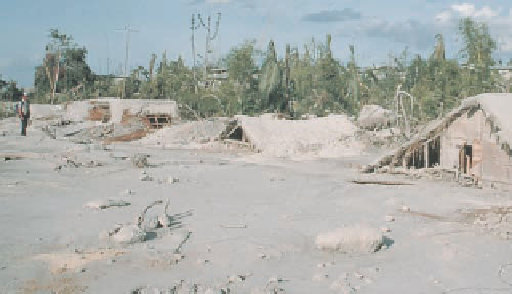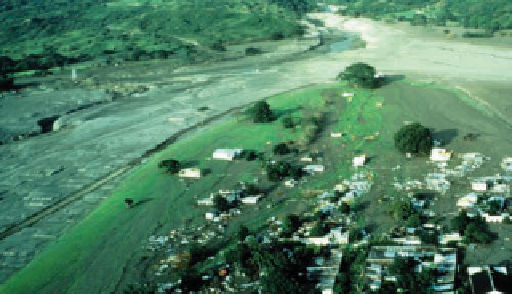Geology Reference
In-Depth Information
◗
Figure 5.11
Lahars or volcanic mud fl ows are common on
composite volcanoes.
Image not available due to copyright restrictions
a
Homes partly buried by a lahar on June 15, 1991, following the
eruption of Mount Pinatubo in the Philippines.
Pyroclastic layers, as well as lava fl ows, both of intermedi-
ate composition, are found in
composite volcanoes
, which
are also called
stratovolcanoes
(see Geo-inSight on pages 120
and 121). As the lava fl ows cool, they typically form andes-
ite; recall that intermediate lava fl ows are more viscous than
mafi c ones. Geologists use the term
lahar
for volcanic mud-
fl ows, which are also common on composite volcanoes. A la-
har may form when rain falls on unconsolidated pyroclastic
materials and creates a muddy slurry that moves downslope
(
b
Aerial view of Armero, Colombia, where at least 23,000 people
were killed by lahars that inundated the area in 1985.
Figure 5.11). On November 13, 1985, a minor erup-
tion of Nevado del Ruiz in Colombia melted snow and ice
on the volcano, causing lahars that killed approximately
23,000 people (Table 5.1).
Composite volcanoes differ from shield volcanoes and
cinder cones in composition, and their overall shape differs,
too. Remember that shield volcanoes have very low slopes,
whereas cinder cones are small, steep-sided, conical moun-
tains. In contrast, composite volcanoes are steep-sided near
their summits, perhaps as much as 30 degrees, but the slope
decreases toward the base, where it may be no more than
5 degrees. Mayon volcano in the Philippines is one of the
most nearly symmetrical composite volcanoes anywhere. It
erupted in 1999 for the 13th time during the 1900s.
When most people think of volcanoes, they picture the
graceful profi les of composite volcanoes, which are the typi-
cal large volcanoes found on the continents and island arcs.
And some of these volcanoes are indeed large; Mount Shasta
in northern California is made up of about 350 km
3
of
material and measures 20 km across its base. Mount
Pinatubo in the Philippines erupted violently on June 15,
1991. Huge quantities of gas and an estimated 3-5 km
3
of
ash were discharged into the atmosphere, making this the
world's largest eruption since 1912. Fortunately, warnings
of an impending eruption were heeded, and 200,000 people
were evacuated from around the volcano. Nevertheless, the
eruption was responsible for 722 deaths (Table 5.1).
◗
Most volcanoes can be classified as shield volcanoes, cin-
der cones, or composite volcanoes. Less common are
lava
domes
, also known as
volcanic domes
and
plug domes
, which
are steep-sided, bulbous mountains that form when vis-
cous felsic magma, and occasionally intermediate magma, is
forced toward the surface (see Geo-inSight on pages 120 and
121). Because felsic magma is so viscous, it moves upward
very slowly and only when the pressure from below is great.
Beginning in 1980, a number of lava domes were emplaced
in the crater of Mount St. Helens in Washington; most of these
were destroyed during subsequent eruptions. Since 1983, Mount
St. Helens has been characterized by sporadic dome growth, and
renewed eruptions in 2004. In June 1991, a lava dome in Japan's
Unzen volcano collapsed under its own weight, causing a fl ow
of debris and hot ash that killed 43 people in a nearby town.
Lava dome eruptions are some of the most violent and
destructive. In 1902, viscous magma accumulated beneath the
summit of Mount Pelée on the island of Martinique. Eventually,
the pressure increased until the side of the mountain blew out in
a tremendous explosion, ejecting a mobile, dense cloud of pyro-
clastic materials and a glowing cloud of gases and dust called
a
nuée ardente
(French for “glowing cloud”). The pyroclastic






Search WWH ::

Custom Search